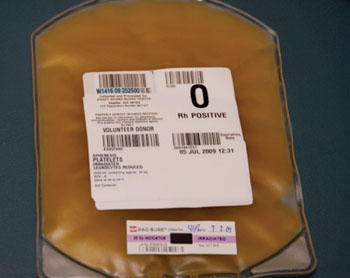Guidelines Issued on Appropriate Use of Platelet Transfusion
By LabMedica International staff writers
Posted on 24 Nov 2014
Platelet transfusions are administered to prevent or treat bleeding in patients with quantitative or qualitative platelet disorders and new guidelines have been issued that specify clinical situations in which platelet transfusion is recommended in adult patients.Posted on 24 Nov 2014
The developed guidelines address several common clinical situations and attempt to identify a platelet count threshold below which platelet transfusion may improve hemostasis and above which platelet transfusion is unlikely to benefit the patient.

Image: A unit of typed platelets for transfusion (Photo courtesy of Seth Eisenberg, RN).
Led by hematologists at the Brigham and Women's Hospital (Boston MA, USA) a team of scientists performed a systematic review of randomized, clinical trials and observational studies that reported clinical outcomes on patients receiving prophylactic or therapeutic platelet transfusions. A literature search from 1900 to September 2014 with no language restrictions was done. Examined outcomes included all-cause mortality, bleeding-related mortality, bleeding, and number of platelet units transfused. An expert panel reviewed the data and developed recommendations using the Grading of Recommendations Assessment, Development and Evaluation (GRADE) framework.
The AABB (formerly, the American Association of Blood Banks, Bethesda, MD, USA) recommends prophylactic platelet transfusion to reduce the risk for spontaneous bleeding in hospitalized adult patients with therapy-induced hypoproliferative thrombocytopenia and a platelet count of 10 × 109 cells/L. There is weaker evidence to suggest that prophylactic platelet transfusion should be administered in patients having elective central venous catheter placement with a platelet count of less than 20 × 109 cells/L or patients having elective diagnostic lumbar puncture or major elective non-neuraxial surgery with a platelet count less than 50 × 109 cells/L.
The team recommended against routine prophylactic platelet transfusion in patients who are non-thrombocytopenic and have cardiac surgery with cardiopulmonary bypass but suggests, without recommending, that those with perioperative bleeding and thrombocytopenia or platelet dysfunction may benefit from transfusion. They concluded that the ideal approach to platelet transfusion would be to administer sufficient platelets to optimize patient outcomes while avoiding unnecessary transfusions with their attendant risks and costs. The recommendations in their guideline reflect the AABB's current thinking on how platelet transfusions should be used in various clinical settings. The study was published on November 11, 2014, in the journal Annals of Internal Medicine.
Related Links:
Brigham and Women's Hospital
AABB













